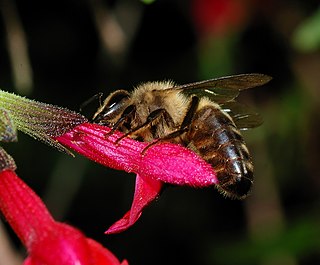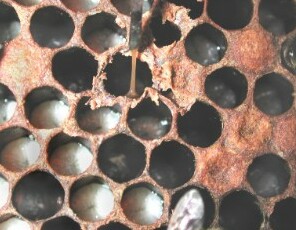
A honey bee is a eusocial flying insect within the genus Apis of the bee clade. They are known for construction of perennial, colonial nests from wax, for the large size of their colonies, and for their surplus production and storage of honey, distinguishing their hives as a prized foraging target of many animals, including honey badgers, bears and human hunter-gatherers. In the early 21st century, only seven species of honey bee are recognized, with a total of 44 subspecies, though historically seven to eleven species are recognized. The best known honey bee is the western honey bee which has been domesticated for honey production and crop pollination; modern humans also value the wax for candlemaking, soapmaking, lip balms, and other crafts. Honey bees represent only a small fraction of the roughly 20,000 known species of bees. Some other types of related bees produce and store honey and have been kept by humans for that purpose, including the stingless honey bees, but only members of the genus Apis are true honey bees. The study of bees, which includes the study of honey bees, is known as melittology.

Insecticides are substances used to kill insects. They include ovicides and larvicides used against insect eggs and larvae, respectively. Insecticides are used in agriculture, medicine, industry and by consumers. Insecticides are claimed to be a major factor behind the increase in the 20th-century's agricultural productivity. Nearly all insecticides have the potential to significantly alter ecosystems; many are toxic to humans and/or animals; some become concentrated as they spread along the food chain.

The Africanized bee, also known as the Africanised honey bee, and known colloquially as the "killer bee", is a hybrid of the western honey bee species, produced originally by cross-breeding of the East African lowland honey bee (A. m. scutellata) with various European honey bees such as the Italian honey bee A. m. ligustica and the Iberian honey bee A. m. iberiensis.

A beehive is an enclosed, man-made structure in which some honey bee species of the subgenus Apis live and raise their young. Though the word beehive is commonly used to describe the nest of any bee colony, scientific and professional literature distinguishes nest from hive. Nest is used to discuss colonies which house themselves in natural or artificial cavities or are hanging and exposed. Hive is used to describe an artificial, man-made structure to house a honey bee nest. Several species of Apis live in colonies, but for honey production the western honey bee and the eastern honey bee are the main species kept in hives.

The European dark bee is a subspecies of the western honey bee, whose original range stretched from west-central Russia through Northern Europe and probably down to the Iberian Peninsula. They belong to the 'M' lineage of Apis mellifera. They are large for honey bees though they have unusually short tongues (5.7-6.4mm) and traditionally were called the German Dark Bee or the Black German Bee, names still used today even though they are now considered an Endangered Breed in Germany. Their common name is derived from their brown-black color, with only a few lighter yellow spots on the abdomen. However today they are more likely to be called after the geographic / political region in which they live such as the British Black Bee, the Native Irish Honey Bee, the Cornish Black Bee and the Nordic Brown Bee, even though they are all the same subspecies, with the word native often being added by local beekeepers, even if the bee was introduced. It was domesticated in Europe and hives were brought to North America in the colonial era, where they were referred to as the English Fly by the Native American Indians.
Nosema apis is a microsporidian, a small, unicellular parasite recently reclassified as a fungus that mainly affects honey bees. It causes nosemosis, also called nosema, which is the most common and widespread disease of adult honey bee diseases. The dormant stage of N. apis is a long-lived spore which is resistant to temperature extremes and dehydration, and cannot be killed by freezing the contaminated comb. Nosemosis is a listed disease with the Office International des Epizooties (OIE).

Varroa destructor is an external parasitic mite that attacks and feeds on the honey bees Apis cerana and Apis mellifera. The disease caused by the mites is called varroosis.

American foulbrood, caused by the spore-forming bacteria Paenibacillus larvae ssp. larvae, is a highly infectious bee disease. It is the most widespread and destructive of the bee brood diseases.

The midgut is the portion of the embryo from which most of the intestines develop. After it bends around the superior mesenteric artery, it is called the "midgut loop". It comprises the portion of the alimentary canal from the end of the foregut at the opening of the bile duct to the hindgut, about two-thirds of the way through the transverse colon.

Apis dorsata, the giant honey bee, is a honey bee of South and Southeast Asia, found mainly in forested areas such as the Terai of Nepal. They are typically around 17–20 mm (0.7–0.8 in) long. Nests are mainly built in exposed places far off the ground, like on tree limbs, under cliff overhangs, and sometimes on buildings. These social bees are known for their aggressive defense strategies and vicious behavior when disturbed. Indigenous peoples have traditionally used this species as a source of honey and beeswax, a practice known as honey hunting.

The western honey bee or European honey bee is the most common of the 7–12 species of honey bee worldwide. The genus name Apis is Latin for "bee", and mellifera is the Latin for "honey-bearing", referring to the species' production of honey.

Apis cerana, the eastern honey bee or the Asiatic honey bee, is a species of honey bee native to southern, southeastern, and eastern Asia. This species is the sister species of Apis koschevnikovi and both are in the same subgenus as the western (European) honey bee, Apis mellifera. A. cerana is known to live sympatrically along with Apis koschevnikovi within the same geographic location. Apis cerana colonies are known for building nests consisting of multiple combs in cavities containing a small entrance, presumably for defense against invasion by individuals of another nest. The diet of this honey bee species consists mostly of pollen and nectar, or honey. Moreover, Apis cerana is known for its highly social behavior, reflective of its classification as a type of honey bee.
Beekeeping in Ireland has been practiced for at least 2000 years and has seen a surge in popularity in modern times, evidenced by the numerous organizations promoting and assisting beekeeping. Despite the increased pressures on bees and beekeepers through new diseases and loss of habitat, there are now in excess of 3,500 members within beekeeping associations.
Acinetobacter apis is a Gram-negative, obligate aerobic and non-motile bacterium from the genus Acinetobacter which has been isolated from the intestinal tract of the bee Apis mellifera. A. apis showed optimum growth at 25 degrees Celsius, pH 6-7, and in the presence of 1% (w/v) NaCl in trypticase soy broth medium. This bacterium was first characterized in 2014.
Bartonella apis is a bacterium from the genus of Bartonella which has been isolated from the gut of a honey bee.

Slow bee paralysis virus (SBPV), not to be confused with Acute bee paralysis virus (ABPV) or Chronic bee paralysis virus (CBPV), is a virus discovered in England in 1974 that infects honeybees, bumblebees, and silkworms through Varroa destructor mite infestations. The virus causes paralysis in the front two pairs of legs of adult bees eventually killing its hosts. The virus is in the iflaviridae family of viruses. Infection by iflaviridae viruses is among the leading cause of death of honeybee colonies. As bees and silkworms are of great economic and biological importance, the virus is the subject of ongoing research.
Bombella intestini is a bacterium from the genus of Bombella which has been isolated from bumblebee crop.













